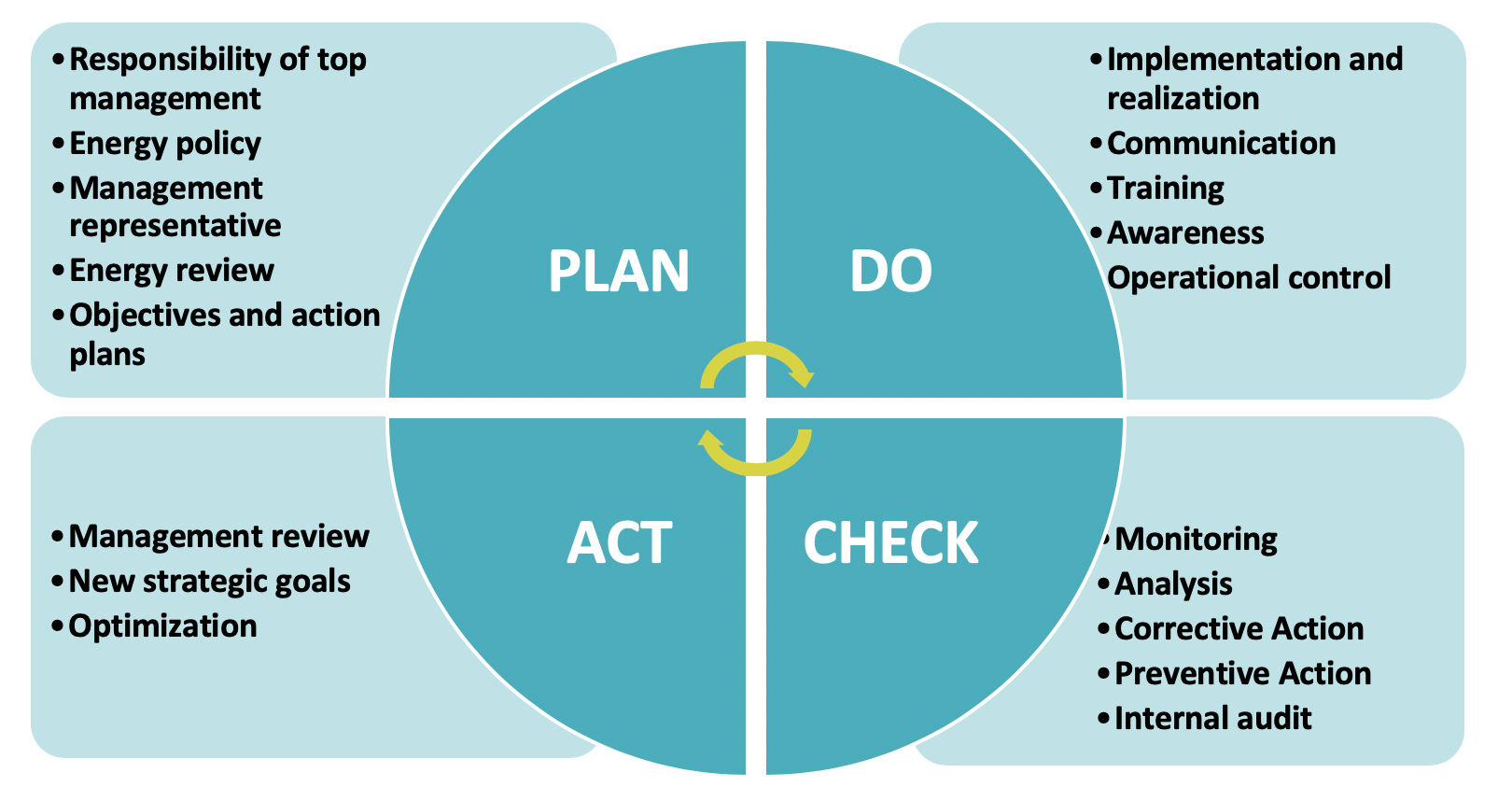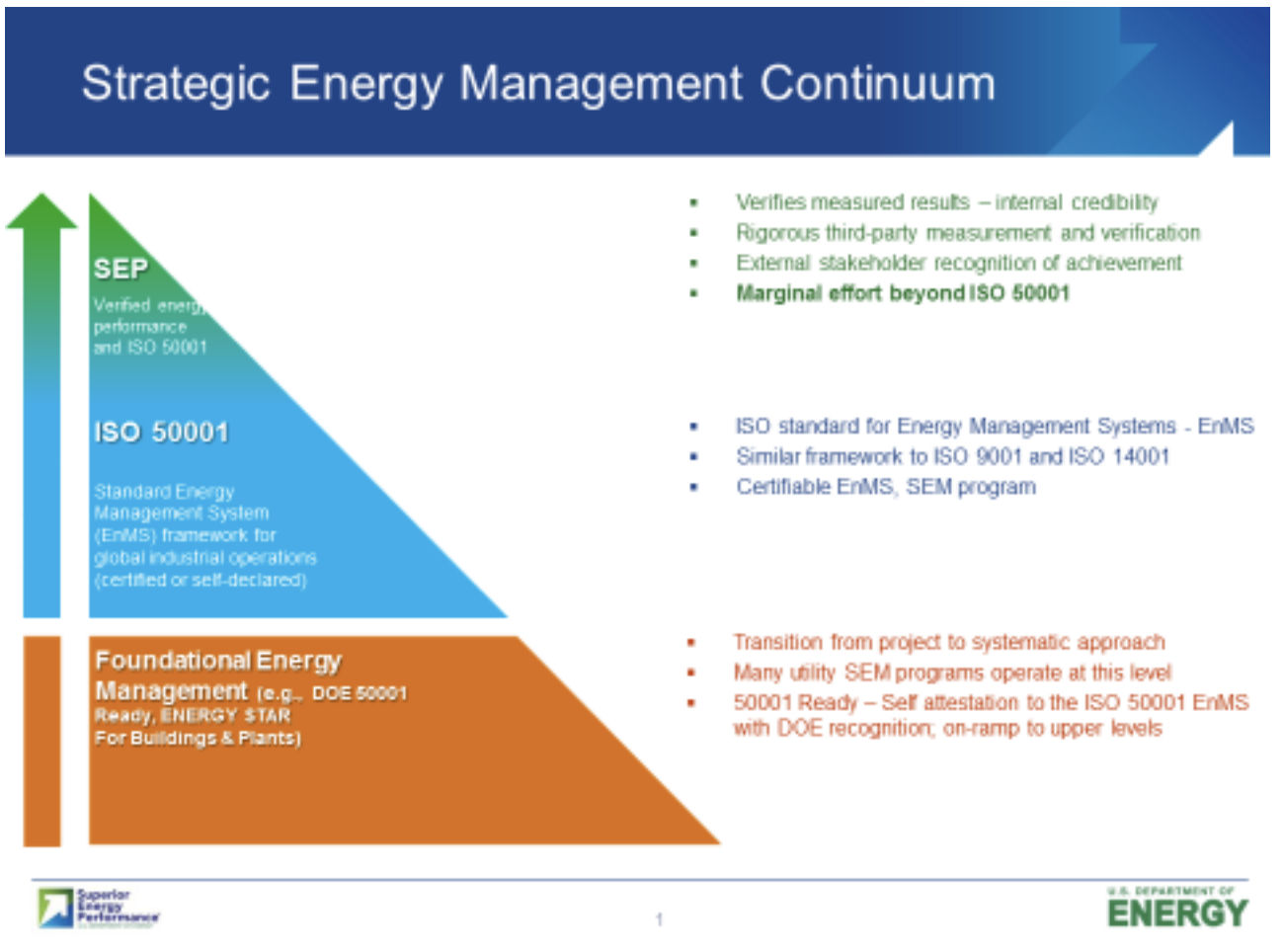By Giselle Procaccianti | Tue, February 12, 19
For over a decade, utilities have rigorously explored a variety of approaches in their quest to achieve predictable and reliable energy savings data. One approach that combines energy efficiency, behavioral changes, and integrated demand-side management is strategic energy management (SEM). SEM is a holistic approach that continuously examines and manages a customer’s energy usage in pursuit of deeper, long-term savings.
NEEP has been supporting the adoption of SEM programs in the Northeast since 2013. Support of these programs does not only reinforce our commitment to achieving our main goal of assisting the Northeast and Mid-Atlantic region to reduce building sector energy consumption by three percent per year and carbon emission 40 percent by 2030, but presents an opportunity for businesses in the region to evaluate their existing energy management practices and to implement procedures that optimize energy use.
The opportunity, in fact, may be huge! According to the recent report released by ACEEE – Features and Performance of Energy Management Programs – SEM programs need more love. National savings could reach seven terawatt-hours per year for the commercial sector and 24 terawatt-hours for the industrial sector by 2030 – the equivalent of all electricity sales in Nebraska in 2017. However, with the current trend in the growth of such programs, both in number and in scope, less than one-tenth of this volume of savings will be achieved by 2030.
So the burning question is, how can those potential savings be realized?
Hopefully this blog will assist in answering this question as it digs a bit deeper into what strategic energy management is all about, how the ISO 50001 standard has made its implementation simpler and more effective, and how NEEP is supporting the implementation of SEM in the Northeast.
Standard SEM Program Implementation

Figure 1: Four phases of the PDCA circle based on the specification ISO 50001.
As shown in Figure 1, SEM programs follow a traditional “plan, do, check and act” (PDCA) cycle, and typically include the following key steps:
Commitment Phase
- Set and communicate continuous improvement objective and long-range energy performance goals
- Ensure SEM initiatives are sufficiently resourced and a responsible individual is designated
Planning and Implementation Phase
- Assess current energy management practices using a performance scorecard
- Develop a map of energy use and cost
- Establish clear, measurable metrics and goals
- Register or record actions to be undertaken to achieve the energy performance goals
- Engage employees
- Implement planned actions
Measuring and Reporting Phase
- Periodically reassess energy performance
- Collect and store performance data, making it available over time
- Analyze energy use data determining relevant variables affecting use compared to a baseline
- Reporting
ISO 50001: Codifying Strategic Energy Management
ISO 50001 is based on the management system model of continual improvement also used for other well-known standards such as ISO 9001 or ISO 14001. This model makes it easier for organizations to integrate energy management into their overall efforts to improve quality and environmental management.
ISO 50001 provides a framework of requirements for organizations to:
- Develop a policy for more efficient use of energy
- Fix targets and objectives to meet the policy
- Use data to better understand and make decisions about energy use
- Measure the results
- Review how well the policy works, and
- Continually improve energy management.
Thousands of companies around the world have implemented energy management systems that follow the ISO 50001 standard and have had their compliance with the protocol certified by independent third parties. Many SEM programs now include technical assistance to help companies adopt the ISO 50001 standard and prepare for certification.
DOE’s support for SEM Programs: 50001 Ready and more
In late 2017, the U.S. Department of Energy (U.S. DOE) launched the 50001 Ready recognition program in an effort to provide companies with a relatively easy, self-guided approach to establish an energy management system in the structure of ISO 50001. The 50001 Ready Navigator online tool provides step-by-step guidance for implementation.
The 50001 Ready program targets organizations of varying sizes, and offers a no-cost way to receive recognition for establishing a business practice around energy by cutting operational costs, achieving continual operational improvement, improving risk management, and staying competitive in the marketplace. More information on becoming 50001 Ready recognized can be found here.
Another SEM recognition program that U.S. DOE developed in 2007 is the Superior Energy Performance (SEP) program. This program recognizes organizations that achieve ISO 50001 certification and third-party verification of energy performance improvement as defined by the SEP Measurement and Verification Protocol.
In general, U.S. DOE’s Advanced Manufacturing Office (AMO) has classified three levels of strategic energy management as illustrated in Figure 2 below. The first level is referred to as foundational energy management. This level is the most basic and includes only the very core aspects of SEM. The next step is becoming certified to meet ISO 50001 energy management standards and the third tier of certification is Superior Energy Performance (SEP). In addition to the three tiers of SEM, U.S. DOE provides multiple resources for industrial facilities.

Figure 2: ISO 50001: Energy Management System
NEEP’s support for Strategic Energy Management
The Northeast Strategic Energy Management Collaborative
In 2018, NEEP established the Northeast SEM Collaborative. This is a working group that offers stakeholders in the Northeast, including energy efficiency programs, a platform to discuss ways to achieve significant energy/carbon savings by accelerating the adoption of SEM.
The goals of the collaborative include: driving accelerated adoption of SEM, with a focus on SEM promotion through energy efficiency programs; enabling collaboration across SEM stakeholders; and developing and sharing effective SEM tools, programs and policies.
The activities of the working group include three quarterly webinar meetings and one annual in-person workshop scheduled to take place within the fourth quarter. Last year’s webinars focused on the key elements of existing and upcoming SEM programs in the Northeast, comparisons of pathways, and lessons learned amongst stakeholders and the adoption of DOE’s 50001 Ready by programs in the Northeast. The 2018 Northeast Strategic Energy Management Collaborative Workshop was a well-attended event that provided an opportunity for attendees to learn about new strategies that drive adoption of SEM as part of energy efficiency programs. It targeted energy efficiency program administrators, implementation experts, and federal program representatives. Key sessions included the following topics: SEM successes in the water/wastewater sector, U.S. DOE’s 50001 Ready Program and the SEM experience from a customer’s perspective.
NEEP’s advancement of DOE’s 50001 Ready Program
With funding from U.S. DOE, NEEP supports the adoption of 50001 Ready in the Northeast.
In 2018, NEEP’s goal was to increase the number of municipal water facilities in the region that participate in 50001 Ready programs. To accomplish this, NEEP developed a strategic energy management module for our CAPEE (Community Action Planning for Energy Efficiency) online tool. This module includes a strategic energy management Factsheet and a supporting informational document, intended to educate CAPEE users about: Strategic Energy Management, ISO 5001 Standard, DOE’s 50001 Ready Program and DOE’s 50001Navigator Tool.
In 2019, NEEP continues to support the adoption of 50001 Ready in the Northeast. The new goal for this year is to establish a pilot program that would get at least five commercial, industrial or municipal end-users to 50001 Ready recognition.
Concluding thoughts
With the support of US DOE and evolving SEM programs, the very concept of SEM has proven to be effective. The idea that there is huge opportunity for expansion of SEM programs is real, and in fact does not exist in a vacuum. With new technologies on board, SEM programs are becoming more sophisticated and organizations are capturing more granular level, real-time data from energy management systems. This equates to more optimized energy use and greater energy savings.
My point? There is no better time than the present to give SEM programs the love that they need! We at NEEP understand the urgency and will continue to do our part to support the implementation and growth of SEM programs in the Northeast and Mid-Atlantic region.
